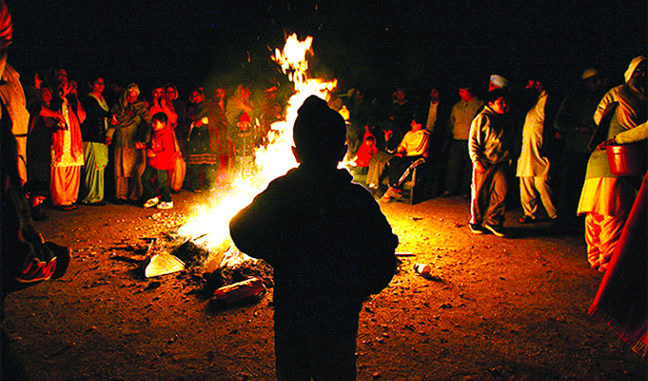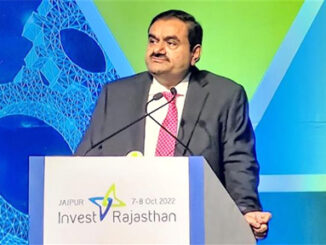
Like most other festivals in India, Lohri is also related to the agricultural activities of the farmers. It marks the harvesting season in Punjab and the end of the winter season. Lohri usually falls on the last day of the month of Paush, a day known as Makar Sankranti in most parts of the country. According to the English calendar, Lohri falls on 13th January every year.
Preparation to celebrate Lohri begins way before the actual festival day. Right through the winter days, village women and children collect dry twigs and branches to make a huge bonfire on the day of Lohri-the bigger the better.
On the day of the festival, with the setting of the sun, the bonfire is lit with people singing and dancing to the tune of Lohri songs.
The munching of seasonal goodies like popcorn, reori, peanuts and sugar cane forms an integral part of the celebration. Fistfuls of these goodies also find their way into the fire, as an offering to the Sun God, the giver of all life. Interestingly, the next day of Lohri is known as Maghi, a day that signifies the beginning of the month of Magh.
According to common belief, this is an auspicious day to take holy dip and give away charity. Kheer is prepared in sugar cane juice to mark the day.
The First Lohri
The festival is symbolic of new beginnings. The first time Lohris are especially celebrated with pomp and grandeur. Friends and relatives gather around the fire and perform Gidda and Bhangra to the beat of Dhol, the drums of Punjab.
The first Lohri of a bride
The new bride and groom sit in a central place together as people approach them with wishes and gifts.
The parents-in-law present the bride with new clothes and jewellery.
The first Lohri of a newborn
The first Lohri of a new-born is of immense significance where the family and friends participate to bless the child with a prosperous and a healthy future.
Many conduct an elaborate get-together at the paternal home, where invitation cards are sent in advance.
Family and friends bring along gifts for the child as well as the new mother.
The maternal and paternal grandparents shower the child with gifts.
Lohri Rituals
This festival denotes the harvesting of the Rabi crops and hence all the farmers get together in order to thank god for giving them such a wonderful harvest.
The rituals related to Lohri symbolize the attachment of the people with Mother Nature. A few days before the festival, youngsters get together in groups and go round their localities singing folk songs.
Doing this they also collect firewood and money for the bonfire that is scheduled on the night of Lohri. On the special day, offerings of phulley (popcorn), moongphali (peanuts) and rewri (a sweet delicacy made out of jaggery and sesame seed) are offered to the fire
The men and women go round the fire and bow before it in reverence. Lohri holds special importance when there is a special occasion in the family like marriage or childbirth.
Traditions
Lohri is primarily the harvest festival of the Punjabis. This festival denotes the harvesting of the Rabi crops and hence all the farmers get together in order to thank god for giving them such a wonderful harvest.
A few days before the festival, youngsters get together in groups and go round their localities singing folk songs.
Doing this they also collect firewood and money for the bonfire that is scheduled on the night of Lohri. On the special day, offerings of phulley (popcorn), moongphali (peanuts) and rewri (a sweet delicacy made out of jaggery and sesame seed) are offered to the fire.
The men and women go round the fire and bow before it in reverence. Lohri holds special importance when there is a special occasion in the family like marriage or childbirth.
Lohri Legends
Like all Indian festivals, Lohri also has some legends and lore attached to it.
One of the many interesting legends has it that in a place that lies between Gujaranwala and Sialkot, there was a thick forest known as Rakh.
The forest was the home of Dulla Bhatti, a dacoit who was considered as the Robin Hood of Punjab.
This brave and generous man was always helpful to the needy.
During the reign of Mughal Emperor Jahangir, a jealous Hindu spread a rumour that his niece was very beautiful and would do credit to the Muslim harem.
On hearing this, the Mughal officers wanted to carry her off forcibly. The girl’s father was extremely worried and sought the protection of Dulla Bhatti.
Dulla at once got her married to a young Hindu boy at a simple ceremony in the forest. He lit the sacred fire in keeping with the Hindu custom.
Since there was no priest to chant the holy mantras, he broke into a hilarious song composed extempore to add cheer to the occasion. This song is sung even today on the occasion.
Religious Fact
As per the Hindu calendar, in the mid-January, the earth starts its journey towards the sun bringing end to Paush, the coldest month of the year. According to the Shrimad Bhagawad Gita, Lord Krishna manifests his full divinity during the period of Lohri. A day later, the auspicious Makara Sankranthi helds which marks the end of the winter season. Thousands of Hindus bath in the Ganges to nullify their sins.
Social Fact
Wheat is the main winter crop in the northern parts of India. This winter (rabi) crop is sown in the months of October and harvested in March or April. Farmers and their families celebrate Lohri during January (rest period) before the cutting of crops. Thus, Punjabis and Haryanavis celebrate Lohri as the “harvest festival”. Most farmers from rural Punjab consider the day after Lohri as the starting of new financial year. The Sindhi community popularly call Lohri as “Lal loee”. On the festive day, children request their grandparents and aunties for wood sticks which are burnt in the bonfire.





Be the first to comment